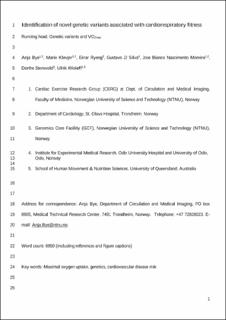| dc.contributor.author | Velle-Forbord, Torbjørn | |
| dc.contributor.author | Eidlaug, Maria | |
| dc.contributor.author | Debik, Julia Barbara | |
| dc.contributor.author | Sæther, Julie Caroline | |
| dc.contributor.author | Follestad, Turid | |
| dc.contributor.author | Nauman, Javaid | |
| dc.contributor.author | Gigante, Bruna | |
| dc.contributor.author | Røsjø, Helge | |
| dc.contributor.author | Omland, Torbjørn | |
| dc.contributor.author | Langaas, Mette | |
| dc.contributor.author | Bye, Anja | |
| dc.date.accessioned | 2020-06-30T07:37:01Z | |
| dc.date.available | 2020-06-30T07:37:01Z | |
| dc.date.created | 2020-01-02T10:50:40Z | |
| dc.date.issued | 2019 | |
| dc.identifier.citation | Atherosclerosis. 2019, 289 1-7. | en_US |
| dc.identifier.issn | 0021-9150 | |
| dc.identifier.uri | https://hdl.handle.net/11250/2659958 | |
| dc.description.abstract | Background and aims
Several risk prediction models for coronary heart disease (CHD) are available today, however, they only explain a modest proportion of the incidence. Circulating microRNAs (miRs) have recently been associated with processes in CHD development, and may therefore represent new potential risk markers. The aim of the study was to assess the incremental value of adding circulating miRs to the Framingham Risk Score (FRS).
Methods
This is a case-control study with a 10-year observation period, with fatal and non-fatal myocardial infarction (MI) as endpoint. At baseline, ten candidate miRs were quantified by real-time polymerase chain reaction in serum samples from 195 healthy participants (60–79 years old). During the follow-up, 96 participants experienced either a fatal (n = 36) or a non-fatal MI (n = 60), whereas the controls (n = 99) remained healthy. By using best subset logistic regression, we identified the miRs that together with the FRS for hard CHD best predicted future MI. The model evaluation was performed by 10-fold cross-validation reporting area under curve (AUC) from the receiver operating characteristic curve (ROC).
Results
The best miR-based logistic regression risk-prediction model for MI consisted of a combination of miR-21-5p, miR-26a-5p, mir-29c-3p, miR-144-3p and miR-151a-5p. By adding these 5 miRs to the FRS, AUC increased from 0.66 to 0.80. In comparison, adding other important CHD risk factors (waist-hip ratio, triglycerides, glucose, creatinine) to the FRS only increased AUC from 0.66 to 0.68.
Conclusions
Circulating levels of miRs can add value on top of traditional risk markers in predicting future MI in healthy individuals. | en_US |
| dc.language.iso | eng | en_US |
| dc.publisher | Elsevier | en_US |
| dc.rights | Attribution-NonCommercial-NoDerivatives 4.0 Internasjonal | * |
| dc.rights.uri | http://creativecommons.org/licenses/by-nc-nd/4.0/deed.no | * |
| dc.title | Circulating microRNAs as predictive biomarkers of myocardial infarction: Evidence from the HUNT study. | en_US |
| dc.type | Peer reviewed | en_US |
| dc.type | Journal article | en_US |
| dc.description.version | acceptedVersion | en_US |
| dc.source.pagenumber | 1-7 | en_US |
| dc.source.volume | 289 | en_US |
| dc.source.journal | Atherosclerosis | en_US |
| dc.identifier.doi | 10.1016/j.atherosclerosis.2019.07.024 | |
| dc.identifier.cristin | 1764999 | |
| dc.description.localcode | © 2019. This is the authors’ accepted and refereed manuscript to the article. Locked until 26.7.2021 due to copyright restrictions. This manuscript version is made available under the CC-BY-NC-ND 4.0 license http://creativecommons.org/licenses/by-nc-nd/4.0/ | en_US |
| cristin.unitcode | 194,65,25,0 | |
| cristin.unitcode | 1920,6,0,0 | |
| cristin.unitcode | 194,65,20,0 | |
| cristin.unitcode | 194,63,15,0 | |
| cristin.unitname | Institutt for sirkulasjon og bildediagnostikk | |
| cristin.unitname | Klinikk for hjertemedisin | |
| cristin.unitname | Institutt for samfunnsmedisin og sykepleie | |
| cristin.unitname | Institutt for matematiske fag | |
| cristin.ispublished | true | |
| cristin.qualitycode | 1 | |

